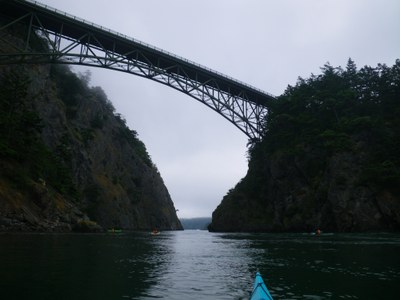
Trip
Sea Kayak - Deception Pass
Explore and play at Deception Pass! A late start + 4 knot ebb = opportunities to sleep in, play, practice, get wet, have fun in a beautiful and dynamic venue.
- Sun, Jun 30, 2024
- Tacoma Branch Sea Kayaking Program
- Sea Kayaking
- Adults
- Sea Kayak IV
- Challenging
- Mileage: 7.0 nm
- Maximum Wind: 20 kts
- Maximum Waves: 3 ft
- Maximum Currents: 4.5 kts
- 2 (7 capacity)
- FULL (3 capacity)
- Cancellation & Refund Policy
Meet at Bowman Bay. Be ready to paddle at 11:10. We'll have a safety talk and short moving-water skills review, then launch at 11:30.
You'll need a Discover Pass or pay the day fee to park at Bowman Bay.
This trip is ideal for paddlers fresh from incident management and moving water clinics who want to hone and enjoy their new skill sets. These classes (incident management and moving water) are the minimum prerequisites for this paddle. If you already have these skills but haven't taken the courses, please describe your skills and experience when you request permission.
We'll launch from Bowman and head out to explore Deception Island. Expect to get wet practicing incident management and rescues on this leg of the trip. As the ebb builds, we will ferry from Deception Island to Canoe Pass. Here, we might be able to make a lap around Pass Island before we break for lunch at Lunch Beach. We will then have about 2 hours to play on the ebb current in Canoe Pass as it builds to a -4.5 knot max at 3 o'clock. We will be back at Bowman around 5.
Helmets and drysuits required.
Bring your short and long towing apparatuses if you have them (you should have them).
Deception Pass
-
Sea Trails Deception Pass and Skagit Bay WA101
NOAA Bellingham to Everett No. 18423
NOAA Anacortes to Skagit Bay No. 18427 - See full route/place details.
Required Equipment
These eight essentials plus The Ten Essentials are required on all sea kayaking trips. All but the whistle and clothing should be provided with any kayak rental.
- Floatation in both ends of the kayak
- U.S. Coast Guard approved Personal Flotation Device (PFD)
- Paddle
- Spray skirt
- Bilge pump with floatation
- Self-rescue paddle float
- Waterproof whistle
- Appropriate clothing for the conditions encountered seasonally
